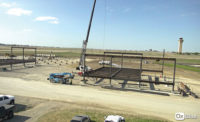A semi-modular bridge system invented in Australia is gaining traction in the U.S. The InQuik system consists of a prefabricated formwork tray with reinforcing steel that is placed on site and filled with concrete to create a fully cast-in-place concrete bridge structure—faster than current methods now used.
Eau Claire County, Wis. last year implemented the first InQuik bridge in the U.S. The 30-ft-long, 27-ft-wide structure was completed in a month, compared to standard three-to-four-month timelines for fully formed cast-in-place bridges, according to InQuik.
Since its debut in Australia about eight years ago, the company has built more than 200 bridges, says President Logan Mullaney. After working with design firm Arup to verify that the system meets Association of American State Highway and Transportation Officials standards, InQuik now is working with individual states to meet their specific requirements, he says.
West Virginia plans to use the system on some sites, says Jimmy Wriston, state Dept. of Transportation commissioner. “I think it’s kind of spectacular,” he says of the technology. “We’ve always been interested in Accelerated Bridge Construction. This fits in that mold. You can load components up, haul them to the jobsite on truck and deliver quickly. I think it will be a boon, especially after flooding or tornadoes.”
Arup staff in Australia “pointed InQuik to us in the U.S.,” says John Eddy, its infrastructure practice lead. “It’s a new application of sensible engineering objectives. They created a system that’s easy to use, doesn’t require heavy equipment and is self-supporting both in transport and being placed.”
The system eliminates longitudinal joints required with precast bridges, he adds. “To be able to pour integrally is really cool. The bridge stems and deck come in at the same time.”
The product range includes deck panels from 21 ft to 60 ft, abutments, wing walls, headstocks and blade piers. The lightweight panels are designed to stack efficiently and ransported on a tractor-trailer. Barrier and handrail fixings can be installed in delivered panels, or before they are placed.
Mike Culmo, chief engineer of engineering consultant CHA, recommended the system to the Utah Dept. of Transportation as one of several options to replace bridges. It "allows you to prefabricate everything but the concrete,” he says. “You can erect [the elements] with small equipment. Usually you’d need big cranes to lift heavy precast pieces. [Inquik] solves the problem of weight and connections between the elements … you don’t have to build formwork or falsework.”
Butler County, Pa., engineer Kevin Gray says InQuik now is obtaining state approval for use there. “I’ve been interested in it and talking to them for years,” he says. “Once it’s approved we can really seriously [consider it]. A lot of our bridges are in rural areas. These are lightweight; to get a concrete beam or steel beams, and a crane, to where we need them can be tough. Some [Inquik panels] can just be picked and set with an excavator.”
Gary Cochrane, co-director of Australia-based East Coast Civil Constructions P/L, says it has used InQuik since 2018, building a 9-meter single-span bridge in one week.
Since then, the company has installed 25 more bridges for local governments in New South Wales—ranging from single-span, single-lane bridges to complex multi-span structures for highways.
“What impresses me most is the seamless blend of simplicity and compliance they offer,” Cochrane says. “These structures not only meet all Australian regulations but also require no maintenance over their 100-year lifespans.”
Mullaney says InQuik is working with various partners to license the technology in different countries, including war-torn Ukraine and is developing iterations of the system for longer spans as well as for rail bridges.
Grey hopes to use the system on some of Butler County’s 20 structurally deficient bridges.
“We can take the old superstructure off and put these in and move forward faster,” he says. "I have a bridge coming up this year, and probably will try it out. Maybe it’s not for every bridge, but under the right circumstances, it might be a perfect setup.”






Post a comment to this article
Report Abusive Comment